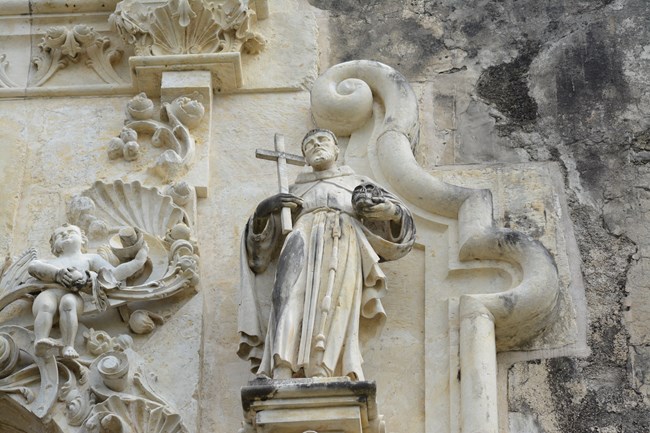
NPS Photo Teaching With Stone"It has a beautiful cupola, though it is overcrowded with unnecessary ornaments with which it is heavily decorated, detracting somewhat from its natural beauty. In a word, no one could have imagined that there were such good artists in so desolate a place." -Father Juan Agustín Morf describing Mission San José in 1778The beauty of Mission San José's church has been recognized for centuries. Today, visitors enjoy the artistry that remains on this magnificent structure. In the past, the colorful frescoes and elaborate stone work served a functional purpose as well. Franciscan missionaries and mission Indigenous families came from diverse cultures, with very different languages. These differences may have made it difficult for missionaries to communicate the concepts of Christianity. The decorations adorning the church were a tool for teaching the faith. Symbols could have helped close the gaps between cultures. Within the intricate stonework of the facade, the colonial artist placed symbols of Catholicism and Spanish culture. Some symbols may have had meaning only to the artist or the inhabitants of the mission. Most, however, are rooted in the long tradition of the Christian faith. 
NPS Image HeartThe human heart, when associated with saints, is symbolic of love, piety, understanding, courage, devotion, sorrow, and joy. The three hearts found on the facade represent the Holy Family. This heart, enclosed in thorns, is the sacred heart, the symbol of Christ's love for humanity revealed through his suffering for all. The heart with the lily personifies Joseph, while the one with the dagger indicates the Archangel's prediction that the events in her life would be as a dagger through Mary's heart.PomegranateThe pomegranate symbolizes the church because of the inner unity of countless seeds in one fruit. A traditional symbol of fertility, the pomegranate and its seeds symbolized the countless and growing number of converts. The juice's deep red color symbolizes the blood of Christ. Most of the flowers seen on the facade are of the pomegranate.ShellThe shell symbolizes baptism, the induction into the faith. Large shells were often used to pour the water upon the person being baptized. It is believed that John the Baptist used a shell to baptize Jesus. Shell designs are frequently found above doorways and windows, symbolizing baptism as the entry into Christianity.RoseThe red rose represents martyrdom, the white rose purity. St. Ambrose taught that roses grew in paradise without thorns. After humanity's fall from grace, roses grew thorns, while their beauty and fragrance remind us of the splendor of paradise.AngelsAs heavenly messengers, angels serve as a link between God and Man, heaven and earth. While there are several classes of angels, the most familiar are the archangels, including Michael and Gabriel. San José's angels are cherubs and bear Native American features in their design.PinjanteThe pinjantes replicate cut paper ornaments used to decorate for festive occasions. Some speculate that this design was also used to symbolize the keyhole in the gate of heaven.Images Cut in StoneWithin an elaborately carved setting, six saints have stood watch over the entrance to Mission San José's church for more than two centuries. Little is known about the construction of this church; we do know that it was almost complete by 1785. That year, Father Josef Augustin Falcon described the church as having "a well-done carved entranceway with six statues carved from the same stone."Why these symbolic figures were chosen is also unknown. As patron saint of the mission. Saint Joseph (San José) holds the highest spot among the statues. Some speculate that the images of Saint Joachim and Saint Anne, who is holding the infant Mary, were used to demonstrate the ideal family to the new converts. Who is on the facade?
PreservationWeathering and time take a heavy toll. While some reconstruction took place in the 1930s and extensive preservation in the early 2010s, most of the original facade remains intact. Today, you can see the handiwork of the early, as of yet unknown, craftsmen.Unfortunately, the facade and church will continue to deteriorate. The Archdiocese of San Antonio is committed through an endowment to maintain San José Church, so descendants of those who labored in this mission may continue to worship here. |
Last updated: April 5, 2024
